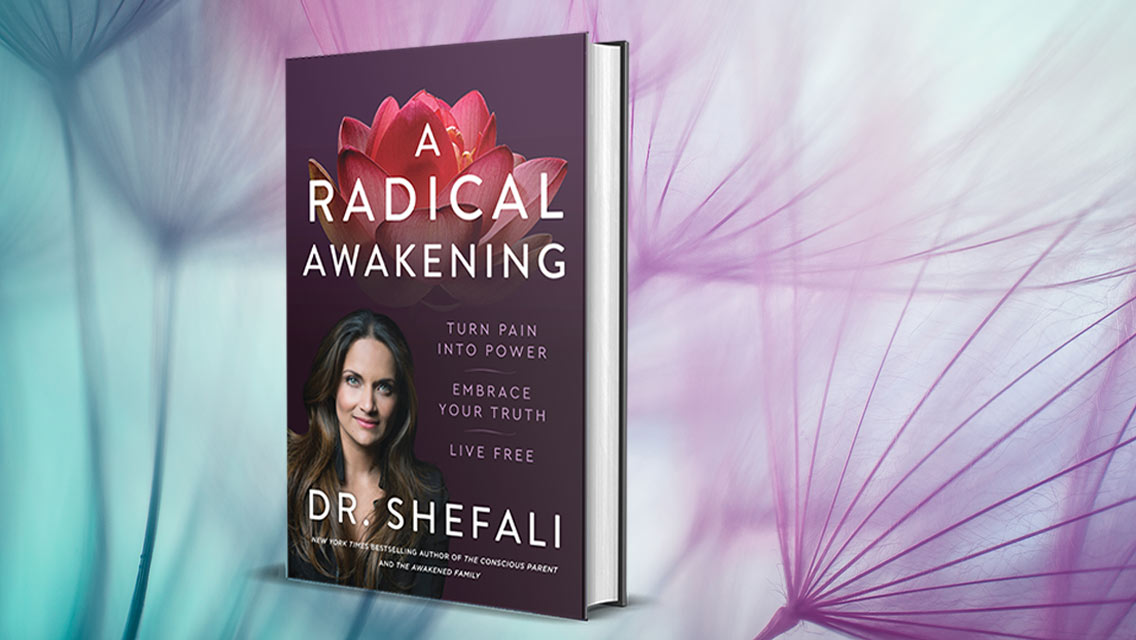Babies love their bodies. I have never seen a toddler lament the size of their thighs or the squishiness of their bellies. Children do not arrive here ashamed of their race, gender, age, or disabilities. Have you ever seen an infant realize they have feet? Talk about wonder! That is what an unobstructed relationship with our bodies looks like.
You did not come to the planet hating your body. In fact, much of how you view your body and your judgments of it are learned things, messages you have internalized that may have created an adversarial relationship of body shame.
That body shame doesn’t just harm your relationship with yourself; it harms other people, too. Your teenager wonders if they will be obligated to hate their body because they see you hating yours. The bodies you share space with are afraid you are judging them with the same venom they have watched you use to judge yourself. Body shame is contagious.
Yet so is radical self-love. And you can learn it, just the way you learned its opposite.
Why radical? Why self-love? When you have spent your entire life at war with your body, concepts like self-acceptance and body neutrality offer a truce (learn more about body-neutral language here). But I believe we all need and deserve more than a cease-fire.
Teaching people how to create radical self-love is my highest calling. It’s what I do with my organization, The Body Is Not an Apology, and with my book by the same name. I offer 10 tools that can help you begin to develop this practice. (If you want to go deeper, check out the book!) Radical self-love is your birthright. It is the foundation of how we make peace with our bodies and the bodies of others and, ultimately, how we change the world.
10 Tools for Radical Self-Love
Tool #1: Dump the Junk
On any given day we may find ourselves at our local grocery store, in line with some organic kale chips, when we feel the energetic tug of the tabloid magazine. Of course we want to know the latest news about Kim Kardashian’s divorce and the “Five Secrets to Solving the Sin of Cellulite.” Before we’re even consciously aware of it, we are handing the cashier a $20 bill for kale chips, Kim K., and diet tips.
Getting sucked into the vortex of escapism is alluring, but that mini mental vacation is not without cost. The content we are exposed to impacts us. Whether we like it or not, we are taking in toxic messages.
Is the answer to swear off all media? No, not unless you’re into that sort of thing. But we can be intentional about the media we ingest. Toxic media that promotes celebrity and diet culture creates a cumulative effect of body shame that erodes our sense of self. It also places a scrim of distrust and scrutiny on the bodies of others over time.
“Dump the Junk” is a tool for detoxifying our lives from mass-media body shame. It turns down the high-decibel volume of body-negative messages, creating some space for us to assess our own bodies and others’ with less background noise.
To actively dump the junk, consider a media fast. Commit to one day per week when you choose not to engage in television, radio, or social-media content that reaffirms negative messages about bodies. Fill your time with new areas of interest. You just gave yourself 15 extra hours a week.
Tool #2: Curb Body Bad-Mouthing
Does this sound familiar? Two friends are in a clothing store trying on clothes, when friend 1 says, “OMG, I look like a cow in this!” Friend 2 retorts, “No you don’t. You look great! Now I would look like a cow in that!” The two proceed to volley mutual accolades over fitting-room doors while tossing body insults at themselves. We call this friendship.
Our society has formed a sense of cultural camaraderie around body shame. It dictates that we affirm one another at the expense of ourselves. How often are we asked to shrink ourselves in size, presence, power?
Couple this with the capitalistic model of scarcity that supposes there is not enough money, space, time, or love for us all, and it’s no wonder we find ourselves abdicating our personal power to uplift our friends.
What happens though when we toss out that tired model and stand unapologetically in our power? We not only embolden ourselves but inspire those we love to do the same.
Singer/songwriter Jill Scott did exactly that in the concert documentary Dave Chappelle’s Block Party. In the film, a reporter and Jill gush over the beloved singer Erykah Badu while Badu is onstage. The reporter asks Scott whether she’s nervous about singing after Badu. Her response: “Have you ever seen me perform?”
Scott did not see shirking her power or shrinking her talent as a prerequisite for appreciating and supporting a fellow artist. Radical self-love does not call on us to be less of ourselves — it summons us to be our most expansive selves.
Notice the words you use to describe yourself negatively. Make a list of some body-shame-free alternatives and use them instead.
Tool #3: Reframe Your Framework
Your body is not the enemy. I know how difficult this concept can be when we feel we’ve been at war with our bodies for our entire existence. Think back to your last cold or flu. Chills, fever, scratchy throat . . . and it’s our mean old body’s fault!
Except those symptoms all mean the body is working overtime to disperse white blood cells to the site of the virus and squash its attack! Our body is fighting on our behalf even as we’re cursing it.
Practicing “reframe your framework” can be confounding for those of us navigating chronic illness or gender nonconformity. It makes sense to feel trapped in a body that feels like it doesn’t have your best interest at heart. It may very well feel like your body is against you. But on the radical-self-love journey, we need to try on new beliefs and actions.
So, we can ask ourselves this: “What peace, power, or joy can be gained from deciding that this body that I’m inextricably tied to for the rest of my life is my enemy?” If the answer is none, then your current framework simply doesn’t serve you.
To call off the battle against your body, consider these questions: How have you tried to fight your body or make it surrender to your will? How have you shown it animosity? How can you practice radical reconciliation?
Tool #4: Meditate on a Mantra
We are hardwired to retain negative experiences as a form of self-protection. This cognitive function is why we haven’t intentionally touched a hot stove since we were 3 or used Aqua Net hairspray since we were 15. These experiences form the informational autobahns of our brains — our neuropathways. And they help to protect us . . . sometimes.
This is where mantras come in. A mantra is a word or a phrase used repetitively. In Sanskrit, mantra means a tool or instrument of the mind. Mantras not only soothe us, but when used with meditation can help to reroute our neuropathways by replacing negative thoughts with new ideas — radical-self-love ideas.
Choosing a mantra is about finding a word or phrase to live by. It should make us uncomfortable. It should make us think, How dare I believe such an audacious thing about myself?
Mantras that challenge our current neurological pathways of body shame will initially trigger those pathways as we endeavor to disrupt them. If you feel a little queasy when you speak your mantra aloud, you’ve probably found the right one. Here are a few mantras you might want to try:
- I love my body.
- I am a vessel of radical self-love.
- My body is my ally.
- I have the body I need to live my best life.
Tool #5: Banish the Binary
Historically, we have used the term “binary” to talk about number sequences. A more contemporary treatment of the term deals with our often rigid and dualistic understanding of gender as strictly male or female, feminine or masculine, and attraction to men or women based solely on those assignments. This inflexibility erases the nuance and diversity of human gender and sexuality.
This either/or thinking also limits the fullness of our human potential and clouds our radical-self-love vision. If “good” and “bad” were choices on a quiz about who we are, the answer would be “all of the above.” Humans (i.e., you and I) are doing and being those things all the time.
Binary thinking that insists we are (or anyone else is) entirely good or bad limits our possibility, squelches compassion, and reinforces narrow ideas of how we get to “be” in the world.
Our behaviors are mutable — of us but not us. Honor that you will be and do many things throughout the course of your life. Sometimes you will be a phenomenal gift; sometimes you will get on someone’s damn nerves. There is gorgeous potential and heinous instinct in us all.
When we find ourselves in the land of either/or thinking — characterized by words like never, always, only, every time, mostly, rarely — it is a great sign that we may be off our radical-self-love path. Ask yourself, How might I approach life differently if I had compassion for my beautiful mess?
Tool #6: Explore Your Terrain
We rarely allow ourselves any level of intimacy with our own bodies. Parts of us have probably gone unobserved, let alone touched, for decades. This negligence is not without cost. A 2003 National Health Industry survey found that 57 percent of breast cancer survivors discovered their cancer through breast self-examination or by accident.
Put plainly, we must touch our bodies. It is impossible to be a responsible steward of a body we constantly avoid being intimate with. Building love relationships requires getting to know the other party. Our relationships with our bodies are no different.
To get to know your body better, I recommend the three E’s of touch: exploration, examination, and ecstasy.
Exploration gives us a baseline understanding of how our bodies look and feel. What colors, shades, and textures make up our landscape?
This is the foundation for the second E, examination. If exploration is a MapQuest of our bodies (it tells us the basics), then examination is the app with real-time traffic updates. Understanding our unique terrain gives us access to awareness, so we can be alerted when something is off-kilter. Noticing skin discoloration or variations in body mass gives us the information we need to advocate for our well-being. Doctors are fantastic, but they do not know your body better than you. Examination makes you an expert in you.
Lastly, touch yourself for ecstasy. “Ecstasy” is not a naughty word. Our bodies are designed for pleasure. Take five minutes and write down the four sensations your body enjoys the most. Include only things that do not require other people. Pick two of them and do them!
Tool #7: Be in Movement
Before the playground became a site of body shame, before crushes and elementary-school politics, there was a swing set, tetherball, you, and 10 to 20 other gleeful little children. After hours of confinement in those uncomfortable wooden desks, recess was body liberation.
But as adults, many of us move from a sense of shame or obligation — and this generally means the movement doesn’t last long.
About three years ago, the voice of the dreaded “should” told me I needed to run a 5K, so I downloaded an app and started to run. Mysteriously, that same loud “should” voice failed to remind me that jogging might not be the most comfortable medium of exercise for a person who wears a size 36JJ bra.
Nevertheless, I found myself pounding the dirt trails of Northern California, sweat stinging my eyes, shoulders cracking beneath the weight of my ample bosom. Jogging made my teeth ache. Literally, my gums would throb with pain at about the 2.5K mark of each run.
About two weeks in I stopped, stood stock still, and asked myself, Why in the hell am I doing this? I hate running! I didn’t want to run. I didn’t like it. What I wanted to do was sign up for a West African dance class and learn the Moribayasa, a dance for women overcoming great adversity.
And that’s exactly what I did: dropped the jogging and found some movement that made me happy. We have a limited shelf life in these bodies, and yes, exercise can be a positive activity — but good for us does not have to equal soul torture.
What were your favorite childhood games? Did you love to go walking along a creek or in the woods? Did you love swimming? Dancing? Why did you stop doing what delighted you? What might happen if you invited those activities back into your life?
Tool #8: Make a New Story
Julie was in her late 20s and of Sicilian descent, a heritage that she said explained the flowing ringlets of chestnut tresses that cascaded down her back. It also explained the wisps of ebony hair that coated her arms and snaked down her cheeks as sideburns. Julie had spent years making peace with the birthright of her DNA, but she couldn’t shake the deep sense of shame about having hair on her back.
Julie had a story she was living in, parts of it given to her by mean children, portions of it passed down through razor commercials and messages of hairlessness as a standard of femininity. All these contributors had written chapters in a book that was making her miserable.
Discomfort is a catalyst for change, and Julie’s discomfort prompted her to make a new story — literally. She wrote a fairy tale in which a little girl named Julie discovers that the hair on her back is the remnant of the angel wings she gave up in order to be born; the gods had left them there to “remind her of her time as an angel child.”
Julie’s new story forever changed the way she saw her body. The hair was no longer a source of shame but part of a whimsical tale of beauty and grace, and it shows that we are the authors of our own lives.
Making a new story reconnects us with our unbounded possibility. What story have you been telling yourself that has been binding your possibility? What would be possible if that story were different?
Tool #9: Be in a Community
In her book The Gifts of Imperfection, Brené Brown writes, “One of the greatest barriers to connection is the cultural importance we place on ‘going it alone.’” A complicated set of systems, structures, and experiences authored our body shame; we cannot dismantle that in isolation.
Being in community is how we interrupt it — it helps us move beyond the narrative of scarcity and not-enoughness.
We need to find communities of care and compassion. In their absence, we’re relegated to an echo chamber of body hatred and oppression.
The good news is that radical-self-love environments are all around us, and thanks to the power of technology, we can connect with people all over the world who are committed to interrupting body shame. (Hint: TheBodyIsNotAnApology.com is a fabulous place to start.)
You can also start by asking yourself these questions: What have you been holding in shame, secrecy, or embarrassment? How has it kept you disconnected from others? What can you let go of for the sake of connection?
Tool #10: Give Yourself Some Grace
No matter how rigorously you embrace these tools, you will still have days when you do not love your body. Here’s the good news: It is perfectly OK!
Despite running an organization focused exclusively on radical self-love, there are still days when I do not like this Black, queer, fat, neurodivergent body.
Does this mean I am a radical-self-love failure? No, it means I am a human being living in a world that still profits from body shame. Every day we awake to messages that reinforce the narrative that we are deficient. The body-shame amplifier will occasionally ring loud enough to drown out the chorus of our divinity. On those days, the work is still to love.
Religious people consider grace the free and unmerited favor of God. This is a gift we can extend to ourselves regardless of faith or doctrine. We do not have to earn radical self-love.
The act of giving yourself some grace is the practice of loving the you that does not like your body. When we feel the most deficient, what is being called forth from us is more love — not because we earned it but because we never had to.
To give grace to oneself is to move beyond words like “worthy” and “deserving,” terms that still imply qualification. When we recognize ourselves as the embodiment of radical self-love, we stop trying to assess our worth. We begin to understand that it is inherent. Love just is. We just are . . . love.





This Post Has 0 Comments